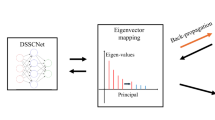Abstract
Manifold learning aims to map the original data from a high-dimensional space into a low-dimensional feature space with possible better discriminative structure. In this paper, we propose a supervised manifold learning approach called SubManifold Individuality LEarning (SMILE). In SMILE, the linear subspace derived from the principal component analysis based on data with the same label is named as “the individual subspace”, while the linear subspace learned from all data is defined as “the global subspace”. For each data sample, the aim of SMILE is to enlarge the diversity between its reconstructed data from individual subspace and global subspace, respectively, so that the intrinsic character of each class can be stimulated in the feature space. SMILE also utilizes the Laplacian matrix to restrict the local structure of data in the low-dimensional feature space in order to preserve the locality of the high-dimensional data. The proposed method is validated in appearance-based face recognition problem on some typical facial image databases via extracting discriminative features. Experimental results show that the proposed approach can obtain the discriminative structure of facial manifold and extract better features for face recognition than other counterparts approaches.





Similar content being viewed by others
References
Abate A, Nappi M, Riccio D, Sabatino G (2007) 2D and 3D face recognition: a survey. Pattern Recogn Lett 28(14):1885–1906
Ahonen T, Hadid A, Pietikainen M (2006) Face description with local binary patterns: application to face recognition. IEEE Trans Pattern Anal Mach Intell 28(12):2037–2041
Belkin M, Niyogi P (2003) Laplacian eigenmaps for dimensionality reduction and data representation. Neural Comput 15(6):1373–1396
Cevikalp H, Triggs B (2010) Face recognition based on image sets. In: IEEE conference on computer vision and pattern recognition (CVPR), pp 2567–2573
Comon P (1994) Independent component analysis, a new concept? Signal Process 36(3):287–314
Cox T, Cox M (2010) Multidimensional scaling. CRC Press
He X, Cai D, Yan S, Zhang H (2005) Neighborhood preserving embedding. In: IEEE international conference on computer vision (ICCV), vol 2, pp 1208–1213
He X, Yan S, Hu Y, Niyogi P, Zhang H (2005) Face recognition using laplacianfaces. IEEE Trans Pattern Anal Mach Intell 27(3):328–340
Hu J, Deng W, Guo J, Xu W (2009) Learning a locality discriminating projection for classification. Knowl Based Syst 22(8):562–568
Li B, Liu Y (2002) When eigenfaces are combined with wavelets. Knowl Based Syst 15(5):343–347
Lu G, Jin Z, Zou J (2012) Face recognition using discriminant sparsity neighborhood preserving embedding. Knowledge-Based Syst 31:119–127
Lu G, Zou J, Wang Y (2012) Incremental learning of complete linear discriminant analysis for face recognition. Knowledge-Based Syst 31:19–27
Martinez A, Kak A (2001) Pca versus lda. IEEE Trans Pattern Anal Mach Intell 23(2):228–233
Mian A, Bennamoun M, Owens R (2007) An efficient multimodal 2D–3D hybrid approach to automatic face recognition. IEEE Trans Pattern Anal Mach Intell 29(11):1927–1943
Muller K, Mika S, Ratsch G, Tsuda K, Scholkopf B (2001) An introduction to kernel-based learning algorithms. IEEE Trans Neural Netw 12(2):181–201
Park U, Tong Y, Jain A (2010) Age-invariant face recognition. IEEE Trans Pattern Anal Mach Intell 32(5):947–954
Press WH (2007) Numerical recipes 3rd edition: the art of scientific computing, 3rd edn. Cambridge University Press, Cambridge
Qiao L, Chen S, Tan X (2010) Sparsity preserving projections with applications to face recognition. Pattern Recogn 43(1):331–341
Roweis S, Saul L (2000) Nonlinear dimensionality reduction by locally linear embedding. Science 290(5500):2323–2326
Seung H, Lee D (2000) The manifold ways of perception. Science 290(5500):2268–2269
Tan X, Triggs B (2007) Enhanced local texture feature sets for face recognition under difficult lighting conditions. Anal Model Faces Gestures, pp 168–182
Tenenbaum J, De Silva V, Langford J (2000) A global geometric framework for nonlinear dimensionality reduction. Science 290(5500):2319–2323
Turk M, Pentland A (1991) Face recognition using eigenfaces. In: IEEE conference on computer vision and pattern recognition (CVPR), pp 586–591
Wang R, Shan S, Chen X, Gao W (2008) Manifold–manifold distance with application to face recognition based on image set. In: IEEE conference on computer vision and pattern recognition (CVPR), pp 1–8
Weinberger K, Saul L (2006) An introduction to nonlinear dimensionality reduction by maximum variance unfolding. In: Proceedings of the national conference on artificial intelligence (NCAI), vol 21, p 1683
Wold S, Esbensen K, Geladi P (1987) Principal component analysis. Chemom Intell Lab Syst 2(1):37–52
Wright J, Yang A, Ganesh A, Sastry S, Ma Y (2009) Robust face recognition via sparse representation. IEEE Trans Pattern Anal Mach Intell 31(2):210–227
Yan S, Xu D, Zhang B, Zhang HJ, Yang Q, Lin S (2007) Graph embedding and extensions: a general framework for dimensionality reduction. IEEE Trans Pattern Anal Mach Intell 29(1):40–51
Yu H, Yang J et al (2001) A direct LDA algorithm for high-dimensional data—with application to face recognition. Pattern Recogn 34(10):2067
Yu W, Teng X, Liu C (2006) Face recognition using discriminant locality preserving projections. Image Vis Comput 24(3):239–248
Zhang S, Lei Y, Wu Y (2011) Semi-supervised locally discriminant projection for classification and recognition. Knowl Based Syst 24(2):341–346
Zhang Z, Zha H (2004) Principal manifolds and nonlinear dimensionality reduction via tangent space alignment. J Shanghai Univ (Engl Ed) 8(4):406–424
Author information
Authors and Affiliations
Corresponding author
Rights and permissions
About this article
Cite this article
Chen, X., Fan, K., Liu, W. et al. Discriminative structure discovery via dimensionality reduction for facial image manifold. Neural Comput & Applic 26, 373–381 (2015). https://doi.org/10.1007/s00521-014-1718-6
Received:
Accepted:
Published:
Issue Date:
DOI: https://doi.org/10.1007/s00521-014-1718-6




